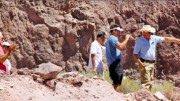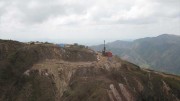Soltoro (SOL-V) may soon be garnering more well-deserved attention for its growing primary silver resource at the El Rayo silver-gold project here in Mexico’s Jalisco State.
The company’s president and CEO, Andrew Thomson, began exploring Mexico in the early nineties, eyeing the country’s overlooked bulk-tonnage, gold-silver potential. After taking Soltoro public in August 2006, Thomson and his team staked seven of the 12 known districts in Jalisco. It now has 11 early stage projects in west-central Mexico. Its most advanced property is the 100-sq.-km El Rayo project.
Located three hours inland from Puerto Vallarta and two hours from the state’s vibrant capital city of Guadalajara, the project sits in a historic silver and gold mining district south of Guachinango, a quaint town that was once the state’s capital. The district was explored by the Spanish conquistadors in the sixteenth century, and was mined until the 1920s and sporadically during the 1960s.
The El Rayo project area hosts mineralized zones where silver, gold and lead have been recovered from 16 underground mines. In the seventies, El Rayo became part of the National Mineral Reserve, and the Mexican Geological Survey carried out an exploration program outlining a non-National Instrument 43-101-compliant resource of 1.36 million tonnes grading 169 grams silver per tonne.
Determined to delineate El Rayo’s full potential, Soltoro has been drilling the property since 2007. The project consists of the 61.8-sq.-km Guachinango 1 concession and the 38.4-sq.-km El Rayo concession. Summex Mines held these concessions in the mid-nineties, but let its claims lapse later in the decade.
Soltoro bought the El Rayo concession from Canadian ex-pat geologist Chris Lloyd – who is also the company’s former vice-president of exploration – in early 2006, and then the Guachinango 1 concession from Fury Exploration later that year. By July 2007, Soltoro had completed 12 holes at El Rayo.
From there, Soltoro has steadily advanced the project towards defining a silver resource of at least 100 million oz. This goal looks plausible, given El Rayo’s current measured and indicated 77.4-million-oz. silver in-pit resource.
The project is located in the east-west-trending trans-Mexican volcanic belt and underlain by Oligocene to mid-Miocene felsic and intermediate volcanic rocks from the Jalisco block.
The company has traced silver-gold mineralization over a 3.5-km strike length. The project’s Las Bolas and Highway zones strike to the northeast and dip to the northwest; the El Rayo zone strikes to the northwest and dips to the northeast; and the La Soledad zone strikes east to west and dips steeply to the north.
By the end of 2010 Soltoro had spent $4.3 million on its flagship asset. It delineated an in-pit measured and indicated resource of 58.3 million contained oz. silver in the Las Bolas and Highway zone deposits. The estimate was updated last December to 64.4 million oz., excluding the Soledad zone.
The 260-metre deep Las Bolas structure contains 90% of that resource. The Highway zone, which is an offset extension of Las Bolas, contains the rest.
Thomson says he’s most proud of the $4.3-million figure, which puts the discovery cost per silver ounce at 7.5¢. “This gives you a real idea of how cheap it is here to define resources,” Thomson told a group of investors and analysts during a presentation in Guachinango in early December.
“El Rayo was found on the side of a road in the shadow of a headframe. And for very little money, we were able to bear out a lot of money for our shareholders,” Thomson added.
Two weeks after the property tour, the junior released a revised resource estimate by assaying another 13,500 metres completed during the 2011 drill program. As a result, measured and indicated resources at El Rayo grew by 30%.
The boost occurred after an initial resource of 13 million oz. silver, with 3.9 million tonnes grading 104.20 indicated grams silver on the La Soledad structure.
Combined, the three deposits host 42.2 million tonnes grading 57.11 grams silver per tonne for 77.4 million oz. in the measured and indicated categories.
The Highway zone and Soledad structures have another 580,000 tonnes at 65.51 grams silver for 1.18 million oz. inferred. This estimate uses a US$27-per-oz. silver price, 72% metallurgical recoveries at the Las Bolas and Highway zone structures and 80% for Soledad.
Soltoro also hosts a small, indicated gold resource of 22,600 oz. from 380,000 tonnes grading 1.85 grams gold on the north end of the El Rayo structure. The deposit has another 18,900 oz. gold from 365,000 tonnes of 1.61 grams gold in inferred.
The company began drilling the Soledad zone in March 2011, discovering two high-grade silver shoots within the 600-metre-long strike tested to date. The central shoot runs 220 metres along strike and the western shoot extends more than 120 metres, open to the west and at depth. The company has tested 10% of the 6-km structure, which also intersects the Las Bolas and Highway zone deposits.
“We are having real success with drilling,” Thomson says, adding that the company hit a 140-gram silver average over 49 metres in the first 12 holes it drilled in Soledad’s central zone.
But the company has seen results on other zones, too. “Every structure we drilled, we hit on,” Thomson explains.
The company is using two rigs to test Soledad along strike, and the historic Catarina mine area for more resources.
In the late eighties, the Geological Survey of Mexico defined a historic, non-compliant resource of 5 million oz. to 7 million oz. silver at Catarina. Aiming to re-establish the resource, the company drilled seven holes last year totalling 1,500 metres into Catarina. Assays are pending.
Soltoro plans to keep working at Catarina, testing the Soledad structure along strike in both directions. It is drill-permitting the new Piedras Amarillas zone, which has a “similar mineralized footprint at surface to that of the Las Bolas structure,” comments Steven Priesmeyer, Soltoro’s vice-president of exploration. The junior is also contemplating bringing a third rig onto the property.
With the price of silver rising dramatically over the past five years, Soltoro is one of the many juniors in Mexico exploring historic mining districts and examining previously ignored, newly viable resources, Euro Pacific Canada’s mining analyst Tony Hayes writes in a research note.
Though many juniors have descended on Mexico, it’s far from being overcrowded, Thomson says.
“People are here because other people are having real success. There’s a bunch of low-hanging fruit, everybody recognizes it, and they are scrambling to get here to pick it all.”
El Rayo has a great location beside a paved road and power lines, and the town of Guachinango, which lies 1 km to the northeast, offers amenities.
“If you ask me why I’m here, it’s because we are finding stuff for very little money,” says Thomson. “That’s what the exploration game is about. It’s not about going to the flavour-of-the-month place because everybody else is doing it. It’s about spending money wisely, putting projects in production and attracting a partner to take an interest, or buy it.”
Soltoro’s El Rayo project caught the eye of Coeur d’Alene Mines (CDM-T, CDE-N) last year. The largest U.S.-based primary silver producer bought 4.5 million Soltoro shares for $1 per share in July. Most of the $4.5 million in proceeds will go towards exploring El Rayo and moving it forward. Coeur now holds 8% of the junior. Pinetree Capital (PNP-T) is Soltoro’s other main shareholder, with 5.6%.
The company has 58.7 million shares outstanding, or 66.8 million fully diluted. It traded below a dollar, closing Jan. 6, 2012, at 90¢ within a 52-week range of 48¢ to $1.49.
As part of the $4.5-million financing, Coeur has agreed not to increase its stake in Soltor
o to more than 9.9%, unless it launches a takeover bid. It also has a first right of refusal to maintain interest in the junior by participating in Soltoro’s next two financings.
In Mexico, Coeur operates the fully owned Palmarejo silver-gold mine in Chihuahua State. The mine started initial production in March 2009.
Pope & Company analyst Hendrik Visagie wrote in a December 2011 research note that there’s a “reasonable chance” El Rayo will be developed with more exploration and improved metallurgy. To date, silver recoveries range from 70% to 80%, but the company intends to bring that closer to 90%.
Soltoro’s CEO says the company has completed a fair amount of mineralogical and metallurgical studies on El Rayo, and is now deliberating on the best way to develop any potential mine.
Soltoro anticipates having these results in hand by this March, and aims to start a preliminary economic assessment by late 2012. Meanwhile, it stays focused on drilling.
“We are not naive to think we are not a good candidate for a takeout,” Thomson reckons. “A lot of senior companies are looking for projects that have a 30-year mine life, and they suddenly have a lot of cash.”
Thomson points out that the features making El Rayo attractive include being in a relatively safe jurisdiction away from drug-related violence in northern Mexico, and boasting a low estimated start-up cost.
Analyst Hayes of Euro Pacific cautions that Soltoro’s net asset value (NAV) is highly sensitive to changes in silver prices. Using US$35 per oz. silver, Hayes calculated Soltoro’s NAV at $2.54 per sharee on an unfunded basis last November. The price was based solely on the El Rayo property.
Another risk Hayes identified was financing. While Soltoro had $7.6 million in cash at 2011’s close, it will need to find more money for any larger development.
In April 2011 Soltoro optioned out the Coyote and Victoria silver-gold, narrow-vein projects in Jalisco State to Argentum Silver (ASL-V). Argentum holds an option to acquire 100% of the properties by issuing Soltoro $255,000 in cash, 5 million shares and spending $1.1 million on exploration over two years.
If the option is exercised, Soltoro would hold a 3% net smelter return royalty (NSR) on each property, where Argentum can buy up to 2% of the NSR by paying US$1.5 million for each percent.
Argentum is conducting exploration work at the 10.5-sq.-km Coyote property, which is located 90 km southeast of Puerto Vallarta and 145 km from Guadalajara, Mexico’s second largest city. The drive from either city takes four hours.
The Coyote project hosts the historic El Tajo mine, which last saw mining between 1890 and 1915. It also contains two underground mines and a handful of smaller surface workings.
Of the dozens of epithermal low-sulphidation vein systems and stockwork zones on the property, there are five main vein systems with a 5-km total strike length. The mineralized zone covers a 2,500- by-2,000-metre area.
Thomson notes Soltoro did a fair amount of trenching on Coyote but never got around to drilling, because he felt it needed slightly higher commodity prices as a narrow vein, high-grade silver-gold project. However, he’s confident that Argentum will move Coyote forward.
Argentum Silver’s president and CEO Warren McIntyre says the company is planning a 2,000-metre program on Coyote this month and aims to outline at least 20 million oz. by year-end.
“Our minimum threshold [when buying a project] is fifty million ounces. Ideally, we wouldn’t spend any money on a property if we didn’t think it had that kind of potential,” McIntyre commented during a tour of the Coyote property in early December.
Argentum’s other Soltoro project is the 111-sq.-km Victoria project, located in the historic Mascota-Navidad mining district 130 km west of Guadalajara. Victoria contains the historic Lupita gold-silver mine. The mineralized zones within the project extend over a 10-km strike length.
While Soltoro seeks partners for its other projects, it is keeping an eye on the El Rayo primary silver deposit with plans to expand the resource.
“El Rayo is starting to smell and feel like it’s much bigger, or has that potential to be world-class,” Thomson concludes.





Be the first to comment on "Soltoro charges ahead in sunny Jalisco"